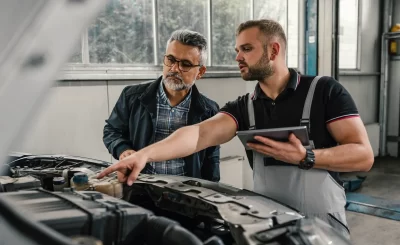Remember when a car’s biggest security threat was a simple lockpick? Those days are, well, in the rearview mirror. Today’s vehicles are essentially smartphones on wheels—powerful computers connected to the internet, talking to other cars, and managing everything from your entertainment to your steering.
And with that incredible connectivity comes a new kind of risk. Automotive cybersecurity isn’t some futuristic concept; it’s the essential shield that protects your vehicle’s digital life from malicious actors. Let’s pop the hood on this critical topic.
Why Your Car is a Target: More Than Just a Ride
It’s tempting to think hackers would only be interested in your personal data. Sure, that’s a big part of it. But the risks go much deeper. A compromised vehicle can lead to real-world, physical danger. We’re talking about unauthorized access that could, in a worst-case scenario, affect braking or acceleration.
Honestly, the attack surface is vast. Here are the main entry points hackers exploit:
- Infotainment Systems: The touchscreen you use for music and navigation can be a gateway to the car’s core networks.
- Telematics Units (like GM’s OnStar or BMW’s ConnectedDrive): These constant communication hubs are prime targets.
- Key Fobs & Passive Entry Systems: Relay attacks can amplify your fob’s signal to unlock and start the car without your knowledge.
- V2X Communication (Vehicle-to-Everything): While promising for safety, this car-to-car and car-to-infrastructure chat is a new frontier for potential interference.
- Even the Tires: Sensors in modern TPMS (Tire Pressure Monitoring Systems) are wireless and can be manipulated.
The Hacker’s Toolkit: How They Get In
So, how do these digital highwaymen actually pull it off? Their methods are as varied as they are clever.
Remote Exploits: The Long-Range Sniper
This is the big one. Hackers don’t need physical access. They can find vulnerabilities in the car’s software—often through its cellular connection or the owner’s smartphone app. A weak spot in the code can let them send commands from miles away. It’s a silent, invisible threat.
Physical Access Attacks: The Digital Slim Jim
If a hacker can plug into your OBD-II port (the one mechanics use for diagnostics), they have a direct line into the vehicle’s nervous system. This can be used to flash malicious software onto critical control units.
Signal Relaying and Jamming
This is a common tactic for theft. Using two devices, a thief can amplify the signal from your key fob (inside your house) to your car parked outside, tricking it into unlocking. Simple, effective, and scary.
The Industry’s Response: Building Digital Fort Knox
Car manufacturers aren’t just standing by. The entire automotive ecosystem is shifting gears. They’re moving from a mindset of “bolt-on” security to “baked-in” protection. This is often called a “security-by-design” approach.
Key strategies include:
- Network Segmentation: Imagine a submarine with watertight compartments. If one area floods, the whole vessel doesn’t sink. Similarly, carmakers are isolating critical systems (like brakes and steering) from less critical ones (like the infotainment screen). A breach in the radio shouldn’t lead to a loss of control.
- Secure Gateways: These act as vigilant guards, inspecting all data coming into and moving around the car’s internal network, blocking suspicious activity.
- Over-the-Air (OTA) Updates: This is a game-changer. Instead of waiting for a dealership visit to patch a vulnerability, manufacturers can push software updates directly to your car, just like your phone. It’s arguably the single most important tool for long-term connected car protection.
What You Can Do: Your Role in the Driver’s Seat
You’re not powerless here. While the heavy lifting is on the manufacturers, you play a crucial role in your vehicle’s cybersecurity posture. Think of it as digital defensive driving.
| Do This… | Avoid This… |
| Install software updates promptly when notified by the manufacturer. | Ignoring update notifications or delaying them for months. |
| Use a Faraday pouch or box for your key fobs at home to block signals. | Leaving key fobs by the front door or in an easily accessible spot. |
| Be mindful of the data permissions you grant to third-party apps connected to your car. | Blindly clicking “accept” on every app’s terms and conditions. |
| Treat in-vehicle connectivity (Wi-Fi, Bluetooth) with the same caution as your home network. | Connecting to unsecured public Wi-Fi networks with your car. |
| Choose strong, unique passwords for your vehicle’s associated mobile app and telematics accounts. | Using the same password for your car app as you do for your email or social media. |
The Road Ahead: An Evolving Journey
The landscape of automotive cybersecurity is a constant race. As cars become more autonomous and connected, the stakes get even higher. The industry is now exploring things like intrusion detection systems that can spot anomalous behavior in real-time, and using blockchain for more secure vehicle-to-vehicle communication.
It’s a collaborative effort—a three-legged race between automakers, cybersecurity researchers, and us, the drivers.
So, the next time you slide into the driver’s seat, remember the incredible technology at your fingertips. That sense of wonder, though, should be paired with a dose of practical vigilance. Protecting your connected car isn’t just about safeguarding data; it’s about ensuring the journey itself remains safe, secure, and yours to control.











